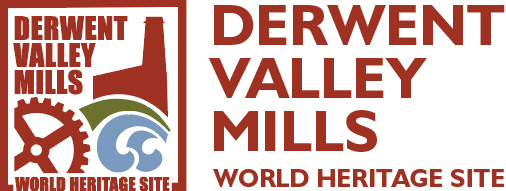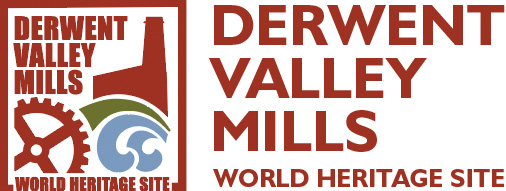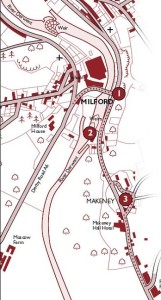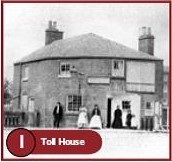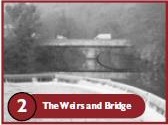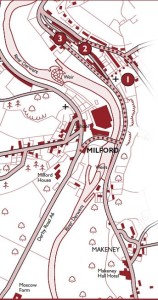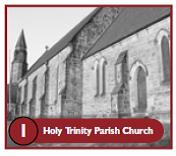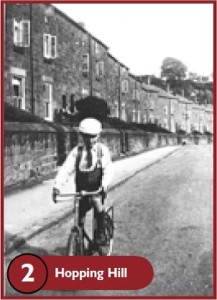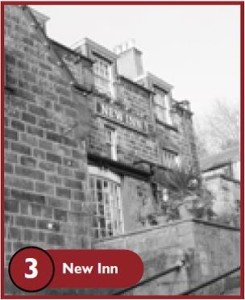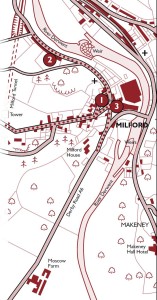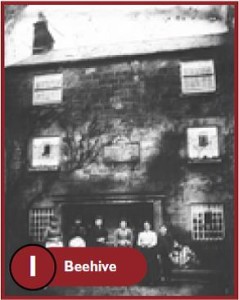Milford Heritage Walks
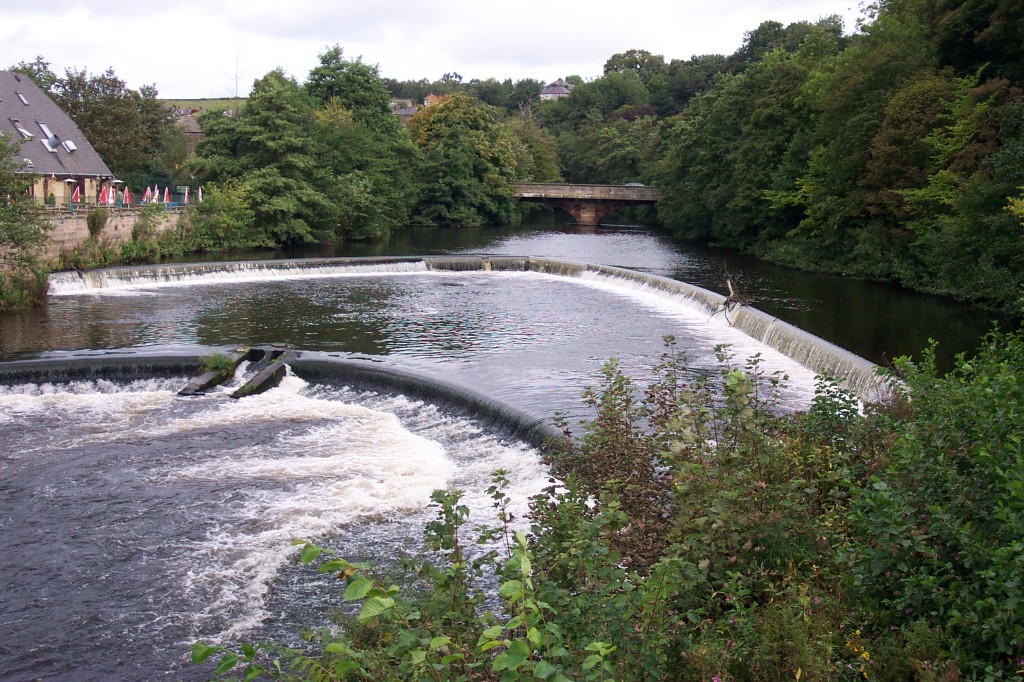
Discover Milford – Milford Heritage Walks
These three Milford heritage walks are set out below, or available as a pdf to download here, best printed on A3:
Milford and Makeney leaflet
Discover Milford and Makeney, two of the key communities within the Derwent Valley Mills World Heritage Site. It was in Milford that Jedediah Strutt and his sons expanded the cotton spinning business they had started in Belper, and by building and buying homes and facilities for their workers created one of the world’s first industrial communities.
From 1781 when Jedediah Strutt began building in the ancient hamlet of New Mills, life here mainly centred on the textile industry. Even today, most buildings in Milford and the neighbouring village of Makeney are linked with the area’s industrial development, and help tell the story of the workers who lived in the shadow of the mills.
In 2001, the universal significance of the textile mills beside the River Derwent was recognised when the stretch of valley between Matlock Bath and Derby was designated a World Heritage Site.
These short walks look at some of the most significant sites in Milford and Makeney. The starting point for each walks is the interpretation board opposite the Strutt Arms on the A6 main road, which will tell you more about this industrial community, and show you how it has changed in the past two centuries.
Makeney Road Walk
Cross the road and carry on to the bridge, opened in 1793. This bridge was initiated by Jedediah Strutt and handed over to the Turnpike Trust. The cost together with the bridge over the cut and the toll houses was £2153 17s 1d. Down below its south-eastern corner are the remains of the Toll House, largely demolished when the bridge was widened in 1906. Tolls were collected for the maintenance of the road and the bridge and to recover the initial cost.
Walk south along Makeney Road. Across the river are the sluice gates for the mills. You can also see the weirs and the paved river bed which ensured fast flowing water. From here also view the footbridge, which replaced a suspension bridge built by William Strutt in 1826 and was demolished just after World War II.
Forge Cottage, further along on the left, was once the home of the forge manager. It still has its iron framed windows. Above the gardens are small cottages developed as one up one down homes for
labourers.
The Fitness Centre, opposite, occupies the site of the ancient forges, and the Corn Mill, built by the Strutt Company in 1820.
Further south along Makeney Road, on the right, is Forge Steps, five houses built – unusually for these villages – of brick. The row was constructed before 1746 for workers at the forges by the Mander family, the earliest known industrial housing in the Derwent Valley.
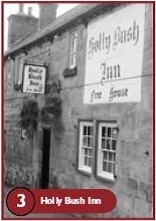 The next turning on the right is the drive of Makeney Hall. Now a hotel, it was the home of Strutt family members until 1928, after the original farmhouse on the site was purchased and rebuilt by Anthony Radford Strutt in 1818. Opposite the drive, a lane leads to the heart of Makeney where the ancient Holly Bush Inn stands beside the old coach road from Derby to Sheffield.
The next turning on the right is the drive of Makeney Hall. Now a hotel, it was the home of Strutt family members until 1928, after the original farmhouse on the site was purchased and rebuilt by Anthony Radford Strutt in 1818. Opposite the drive, a lane leads to the heart of Makeney where the ancient Holly Bush Inn stands beside the old coach road from Derby to Sheffield.
Further along Makeney Road on the left is the former coach house and garage to Makeney Hall, now converted into mews housing, and built by George Herbert Strutt on the site of Makeney House. This had been the home of John Heath, a notorious Derby banker who became bankrupt. Adjacent on the south side in Makeney Yard is a 15th century former farmhouse, bought by the Strutt Company from the Brooks Johnson family of Coxbench Hall in 1806. Also within Makeney Yard is East and West Terrace built in 1820 by the Strutt Company as a block of eight back to back houses.
Beyond the Terrace, on the corner of Red Lane, we see Makeney Lodge, built in 1730 by Henry Peat, and extended in 1783 by his son. By 1852 it was the home of mill manager Captain Holmes, and in the 20th century that of H. St John D. Raikes, MP.
On the opposite corner is Red Hill Farm, built in 1834 by Anthony Radford Strutt as a model farm. Visible across the river is Moscow Farm, another model farm, developed in 1815 by the Strutt Company.
Retrace your steps to follow the other walks.
East Milford Walk
Using the crossing by the Strutt Arms, walk to the river bridge. The buildings to your left are all that remain of the old Milford Mill complex. The footprint of the mills is no longer traceable, but the cut or goyt, two wheel-pits and generator housing survive south of the bridge, close to the Soi Kitchens restaurant. Water power is still harnessed for energy supply. Facing you at the end of the bridge is a group of properties developed between 1791 and 1850 after the enclosure of the common land.
The former Ebenezer Chapel on the right, was converted in 1859 from the Durham Ox public house, built in 1846 by Henry Brassington. The neighbouring King William pub was built around 1830 on land purchased by the Belper auctioneer, surveyor and architect John Hutton. Further north, the Recreation Ground occupies an area worked as a quarry until at least 1906.
Holy Trinity Parish Church was built between 1846 and 1848 in an early English style by H Moffat. Its unusual north-south alignment is due to the constraints of the site, donated by Strutt family members. It stands at the south end of Hopping Hill, part of the former turnpike road named from the Old English word ‘hop’ meaning a hanging (or side) valley and ‘ing’ meaning a clearing.
The long rows of housing here were developed on the former common land between 1792-6 by Jedediah Strutt to house his workers. Thirty years later, purchase of land from the Duke of Devonshire enabled the Company to construct the present main road – allowing their carts to avoid the hill – and build the properties known as Duke’s Buildings.
Cross the main road and pass through a small opening in the wall for a path leading down to the river, and giving spectacular views of the weir. An information board gives more detail about this area, and another is situated close to the site of the former Hopping Mill, a corn mill with a fulling and dyeing house. Part of this site was purchased by Jedediah Strutt in 1781 to obtain the water power needed for his cotton mill 500 yards downstream. The mill meadow became part of the Strutt Company gas works and foundry.
Return to the main road and climb the steps by the New Inn (1792), before turning right onto Hopping Hill. Take the jitty between the two long rows, and turning right at the top proceed up Shaw Lane. A short way along on your right, are East and West Terraces (1818-20). To make optimum use of a difficult site, this back-to-back housing was built in blocks of five; each block having two east-facing double-fronted two-storey houses, and three single-fronted three-storey houses facing west across the valley.
Steps at the far end of the Terrace lead down past allotment gardens and the Church back to the War Memorial and Roll of Honour.
Retrace your steps south along the main road to follow the other walks.
West Milford Walk
The Strutt Arms (1901), opposite the information board, was built on the site of a farmhouse, the home of the Harvey family.
Walk south to Mount Pleasant, one of Milford’s oldest houses. Its gable is dated 1672, but it may be even older. Neighbouring Milford House (1792) was built by Jedediah Strutt who lived there until his death in 1797. It was a Strutt family home for over a century.
Retrace your steps into Chevin Road. The building at the bottom of Sunny Hill now occupied by the Social Club was originally the New Inn, and later the Beehive, before being converted into Milford’s Institute and Reading Room by George Herbert Strutt, in 1902.
A short way up the hill on the right is the Royal Oak, which with the adjoining houses was built by the Bate family on a plot allotted to their father when the common land was enclosed in 1791-2. The licence was held until the 1950s.
A few yards further up on the left, numbers 15-37 form a back-to-back row, built in stages between 1791 and 1824 by entrepreneurs. Its local name, The Barracks, suggests it was built to attract single mill-workers living away from home. Most of the old stone houses on Sunny Hill were built from 1791 and later sold to Anthony Radford Strutt to house his workers.
At the top of the hill, directly over the Chevin railway tunnel, stands Stephensons’ Tower. Built about 1839 by the North Midland Railway Company (Chief Engineers: George and Robert Stephenson), it was used to signal to locomotive drivers that the tunnel, initially single track, was clear to enter and later, after a second track had been laid, to prevent two trains being in the tunnel at once whilst open carriages were still in use. (Please note that there is no public access to the Tower, which stands on privately-owned land.)
Returning down the hill, turn left into Well Lane to see a row of 1792 workers’ cottages built by Jedediah Strutt. The well, by the bend, was hidden for many years, but rediscovered in 2002.
At the end of the lane, the Methodist Chapel (1842) has been in commercial use since the 1940s although recently converted to residential use. The Baptist Chapel (1849), nearby on Chevin Road, is still used for worship – its baptismal tank survives in the basement.
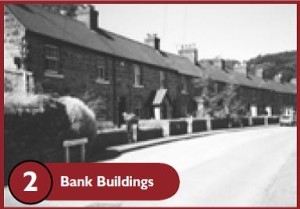
Further north, past the entrance to Hopping Hole quarry, is Bank Buildings, built in 1911 to replace a row of 1790s workers housing. Families were re-housed three at a time while the properties were re-built by the Strutt Estate. The houses have gardens across the road, on the river bank. A short way past the end of the row is the north entrance to Milford Tunnel.
Turn back southwards, and on your left is Milford School, in use since at least the 1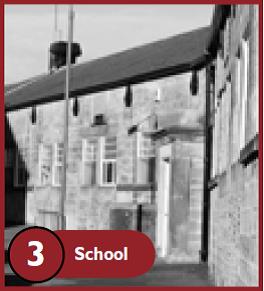 820s. As the building is built into the slope, there is a lower storey at the rear, from where a gate leads to the Mill site.
820s. As the building is built into the slope, there is a lower storey at the rear, from where a gate leads to the Mill site.
Down the steps is Chevin Alley (1792), a row of houses with an irregular façade reflecting the sharp slope down to the road. The courses of stonework are horizontal at the front, but at the back follow the slope of the ground! The extension at No 1 once housed a Post Office. The next-door building, on the main road, housed the Mill Canteen.
